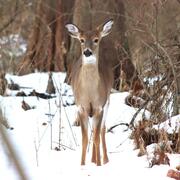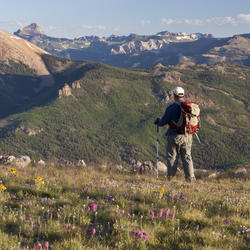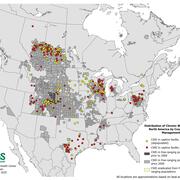Chronic Wasting Disease
Chronic wasting disease (CWD) affects cervids (elk, moose, mule deer, and white-tailed deer) throughout the U.S. CWD affects the nervous system in these animals and creates distinctive brain lesions. At this time, we have no treatment for CWD and it is fatal to the animals who contract it.
CWD is caused by an infectious, irregular form of cellular prion protein. CWD can be directly and indirectly transmitted through the contact with saliva, urine, feces, and infected carcasses, or CWD contaminated environmental surfaces.
USGS scientists are studying CWD to determine how the disease is transmitted, whether sex and/or age of the animal play a role in infection, and whether a genetic resistance is present in some animals.
CWD Research
Assessing the Ability of Incineration to Inactivate CWD Prions from Carcasses
Application of a systems approach for management of chronic wasting disease
EESC Makes an Impact: Preserving our Hunting Resources
Social and economic analysis research in support of public safety, outdoor recreation, and economic growth
USGS Chronic Wasting Disease Research at NOROCK
USGS Chronic Wasting Disease Research at the National Elk Refuge
Expanding Distribution of Chronic Wasting Disease
The influence of natural mineral licks on wildlife disease dynamics
Predicting the effects of supplemental feeding and chronic wasting disease in Greater Yellowstone Ecosystem elk
Chronic Wasting Disease
Modeling chronic wasting disease prevalence through time to investigate mechanisms of spread in deer and elk in Wyoming
Examining PRNP gene frequencies and ‘resistance’ to chronic wasting disease
Decision science support for Chronic Wasting Disease
Enhanced Capacity for Chronic Wasting Disease Research and Certified Diagnostics at the USGS National Wildlife Health Center
Advancing the Use of RT-QuIC for Applications in CWD Management
Chronic Wasting Disease
Effects of population density on prevalence of chronic wasting disease, physical condition, and vital rates of elk at Wind Cave National Park, South Dakota
A complete listing of USGS chronic wasting disease (CWD) data is available from the button below.
Chronic Wasting Disease distribution in the United States by state and county (ver. 3.0, June 2025) Chronic Wasting Disease distribution in the United States by state and county (ver. 3.0, June 2025)
A complete listing of USGS chronic wasting disease (CWD) publications is available from the button below. To find additional publications related to bighorn sheep, search bighorn sheep pneumonia in the search box in the blue navigation bar at the top of the page.
U.S. Geological Survey science strategy to address chronic wasting disease and cervid health in 2024–2028 U.S. Geological Survey science strategy to address chronic wasting disease and cervid health in 2024–2028
Chronic wasting disease (CWD) affects cervids (elk, moose, mule deer, and white-tailed deer) throughout the U.S. CWD affects the nervous system in these animals and creates distinctive brain lesions. At this time, we have no treatment for CWD and it is fatal to the animals who contract it.
CWD is caused by an infectious, irregular form of cellular prion protein. CWD can be directly and indirectly transmitted through the contact with saliva, urine, feces, and infected carcasses, or CWD contaminated environmental surfaces.
USGS scientists are studying CWD to determine how the disease is transmitted, whether sex and/or age of the animal play a role in infection, and whether a genetic resistance is present in some animals.
CWD Research
Assessing the Ability of Incineration to Inactivate CWD Prions from Carcasses
Application of a systems approach for management of chronic wasting disease
EESC Makes an Impact: Preserving our Hunting Resources
Social and economic analysis research in support of public safety, outdoor recreation, and economic growth
USGS Chronic Wasting Disease Research at NOROCK
USGS Chronic Wasting Disease Research at the National Elk Refuge
Expanding Distribution of Chronic Wasting Disease
The influence of natural mineral licks on wildlife disease dynamics
Predicting the effects of supplemental feeding and chronic wasting disease in Greater Yellowstone Ecosystem elk
Chronic Wasting Disease
Modeling chronic wasting disease prevalence through time to investigate mechanisms of spread in deer and elk in Wyoming
Examining PRNP gene frequencies and ‘resistance’ to chronic wasting disease
Decision science support for Chronic Wasting Disease
Enhanced Capacity for Chronic Wasting Disease Research and Certified Diagnostics at the USGS National Wildlife Health Center
Advancing the Use of RT-QuIC for Applications in CWD Management
Chronic Wasting Disease
Effects of population density on prevalence of chronic wasting disease, physical condition, and vital rates of elk at Wind Cave National Park, South Dakota
A complete listing of USGS chronic wasting disease (CWD) data is available from the button below.
Chronic Wasting Disease distribution in the United States by state and county (ver. 3.0, June 2025) Chronic Wasting Disease distribution in the United States by state and county (ver. 3.0, June 2025)
A complete listing of USGS chronic wasting disease (CWD) publications is available from the button below. To find additional publications related to bighorn sheep, search bighorn sheep pneumonia in the search box in the blue navigation bar at the top of the page.


















